There is that old expression: You get what you pay for. We did not pay a lot for the three snubnose revolvers tested below; in fact, we wanted to see what new revolvers were available for about $400 because we feel protection should fit in everyone’s budget. We found the Charter Arms Off Duty, Rossi Model R35102, and Rock Island Armory (RIA) Model 206 as not inexpensive choices, but not horribly spendy either. Note that we did not use the word “cheap,” since cheap implies lack of quality.
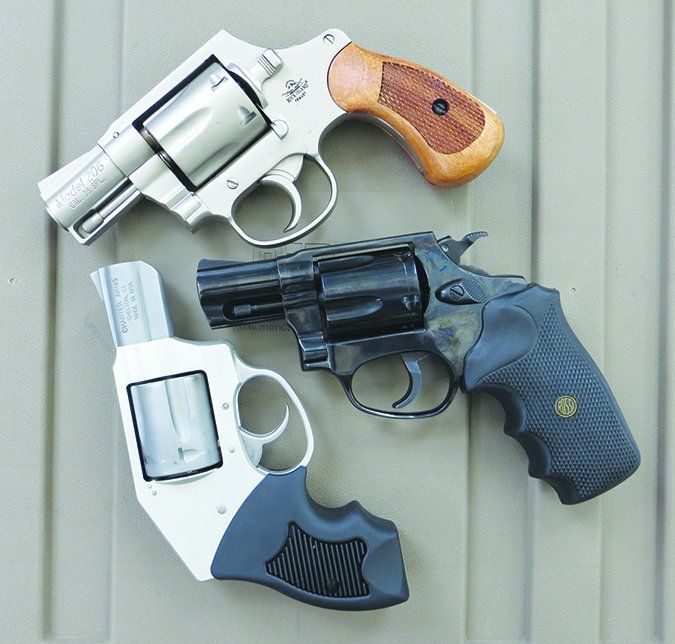
We felt all of these were well made, and we believe these revolvers will perform their designed task of self defense. They are also safe to carry fully loaded and concealed, since they are equipped with internal safety systems that require the trigger to be pulled fully to the rear to fire a round. If accidentally dropped, none of them will fire.
Snubnose revolvers like these three offer the user simplicity since there are no manual safeties, magazine-release buttons, slide stops or any other controls on the revolver other that the cycler latch. There is no magazine to lose since the revolver feeds off an attached cylinder. The double-action trigger pull on all three revolvers provided enough resistance — some were easier to press than others — so that in a high-stress situation, we felt they would be quite adequate and be less likely to be accidentally discharged.
All were metal-frame revolvers chambered in 38 Special and sported 2-inch barrels. The Rossi and Charter Arms models have 5-round capacities, while the RIA can carry 6 rounds. Because we also wanted to carry these revolvers, we looked at spurless and concealed-hammer models, which were the RIA and Charter Arms, respectively. The Rossi was a traditional SA/DA revolver with an exposed hammer with spur.
After running these revolvers, we found we liked a lot about all of them, but, as always, we noted some specific details about them we did not like. Our biggest gripes were the trigger pulls and grips, as we note below. Accuracy with some of these short-barrel protectors was a pleasant surprise.

All three were marked 38 Special, and we read the manuals to see if the guns were safe to use +P ammo. The Rossi manual stated it was compatible with +P ammo, but not to use +P frequently. We decided to test with 38 Special regular-pressure ammunition only, and acquired some Federal Champion 158-grain lead roundnose (LRN) cartridges, some Armscor 158-grain Full Metal Jacket (FMJ) rounds, and Hornady Custom fodder loaded with 158-grain XTP hollowpoints. Felt recoil with this ammunition varied widely.
A $400 revolver will exhibit some characteristics, such as fit and finish, that are not going to be nearly as nice as a revolver costing twice as much because finishing a firearm can be labor intensive and costly. What we concentrated on were the functional aspects: triggers, sights, grips, accuracy, concealability, and ease of use. Here is what we discovered:
Rock Island Armory Model 206 51289 38 Special, $320
GUN TESTS GRADE: B-
The Model 206 gave good accuracy for a DAO revolver;the grip was dated.
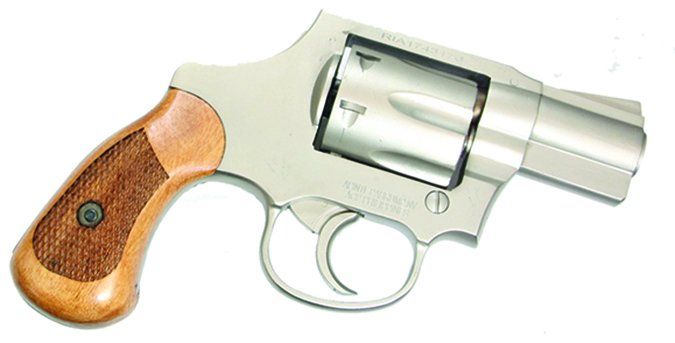
| ACTION TYPE | Revolver, double action only |
| OVERALL LENGTH | 9.25 in. |
| BARREL LENGTH | 2 in. |
| SIGHT RADIUS | 4 in. |
| OVERALL HEIGHT | 5.45 in. |
| MAX WIDTH | 1.4 in. |
| WEIGHT UNLOADED | 24 oz. |
| WEIGHT LOADED | 29 oz. |
| CYLINDER GAP | .007 in. |
| CAPACITY | 6 |
| FRAME FINISH | Matte nickel |
| BARREL/CYLINDER FINISH | Matte nickel |
| FRAME FRONT STRAP HEIGHT | 2.9 in. |
| FRAME BACK STRAP HEIGHT | 2.7 in. |
| GRIP | Checkered wood |
| GRIP THICKNESS | 1.3 in. |
| GRIP CIRCUMFERENCE | 5.12 in. |
| FRONT SIGHT | Ramped blade |
| REAR SIGHT | Fixed groove |
| TRIGGER PULL WEIGHT (DA) | 14 lbs. |
| SAFETY | Internal transfer bar |
| WARRANTY | Limited lifetime |
| TELEPHONE | (775) 537-1444 |
| WEBSITE | Armscor.com |
| MADE IN | Philippines |
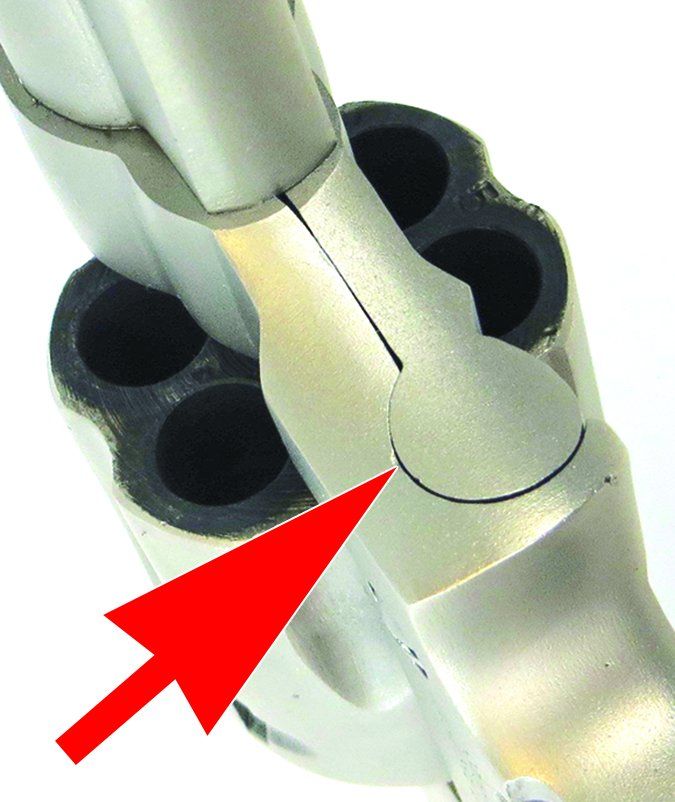
The RIA, imported by Armscor, is a traditional steel-frame snubnose with a look that seemed frozen in time. The Model 206 is similar to a Colt DA revolver design with a cylinder latch that is pulled rearward to swing open the cylinder. The cylinder also rotates clockwise like a Colt. In fact, the action reminded us of a Colt Mark III J-series action with a coiled mainspring, such as that found on the Colt Official Police first produced in 1969. The RIA was equipped with a crowned 2-inch barrel with a full underlug that houses the knurled ejector rod. The front ramp sight was machined into the top of the barrel. The ramp was not serrated, so there was some glare when aiming in direct sunlight.
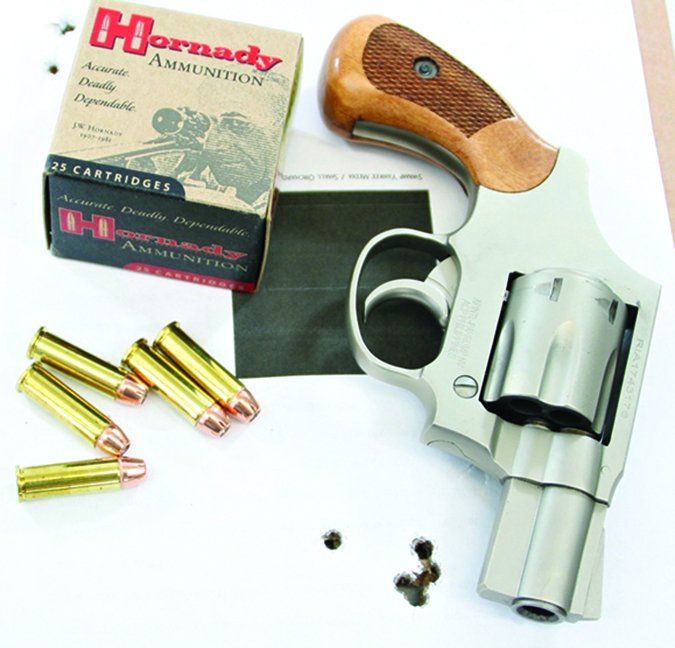
This Model 206 is the spurless model. The hammer sits flush with the rear of the frame, and it is DAO only. The fit of the side plate and crane to the frame showed slight gaps, something a more expensive revolver would likely not display. The 6-shot cylinder slightly wiggled when in battery, but not as much as the Rossi. The Charter Arms had the best lock up, in our opinion. Tooling marks were evident on the exterior, though the satin nickel finish was evenly applied.
The grip was the first characteristic noted by team members that looked dated and vaguely resembled a revolver grip design from a century ago. The grip was constructed of fairly nicely checkered wood, and the wood-to-metal fit was okay, with some overlap of the wood. At the butt, the grip bulged out; toward the top of the back grip strap, it was very narrow. That space just behind the trigger guard, which revolver manufacturers have been filling with grip for decades, was open. In hand, it was hard to get a solid and firm grip because of this space. Because the 206 resembled a Colt, we would check to see if a pair of Colt aftermarket grips would work with the RIA.
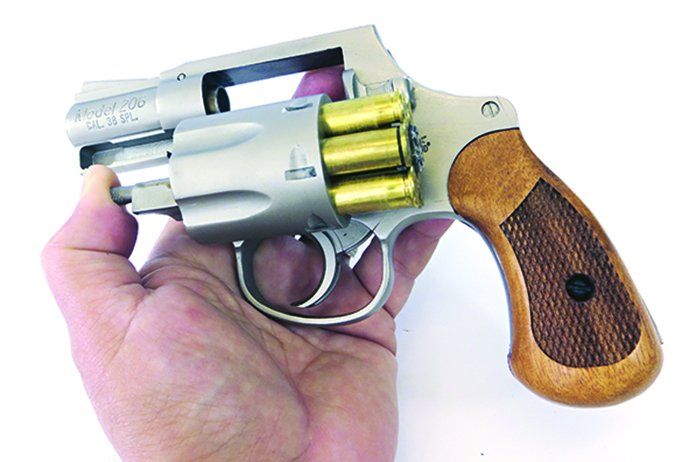
A transfer-bar safety system was employed with the RIA along with the firing pin located in the frame, like the Charter Arms. The Rossi had the firing pin located on the hammer. The trigger needs to be pulled all the way rearward for the revolver to fire.
On the plus side, the sights were large and easy to acquire. We found the trigger was the second smoothest of the three, with minimal stacking in the final press. It measured 14 pounds at the break, but felt less. The trigger was wide and smooth.
The RIA was the largest of the three guns tested but was not that much heavier that the 5-shot Rossi. We liked that it held six rounds and was only 0.1 inch fatter than the other two revolvers, which makes a difference in IWB carry.
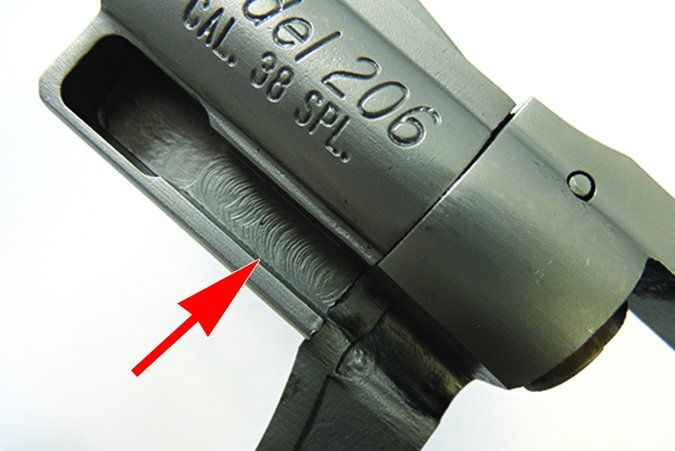
At the range, we were pleasantly surprised to see the RIA was accurate. In fact, it was the most accurate of the three tested. Some team members were able to shoot six shots into one ragged hole. With the Federal and Armscor ammo, five-shot groups using a rest at 15 yards were a half-inch or less. They grew to 0.6 inches with the Hornady ammo. During recoil, that narrow portion of the backstrap slapped the webbing of our hand as severely as the lightweight Charter Arms, even though the RIA was the largest and heaviest of the guns tested. As such, we had a hard time finding a holster to fit it. We improvised with a Galco holster and found the larger RIA was not as comfortable to carry as either the Rossi or Charter Arms, in our view.
Our Team Said: The Model 206 was not as nicely manufactured as the other two, and the grip needs to be updated, but it was accurate. Also, the trigger was the second best of the three tested, and it held six rounds for a 20 percent edge in capacity over the 5-shooters.
Rossi Model R35102 38 Special +P, $390
GUN TESTS GRADE: B
The R35102 had the best trigger and the most comfortable and largest grip; the spurred hammer could get hung upin a draw from concealment.
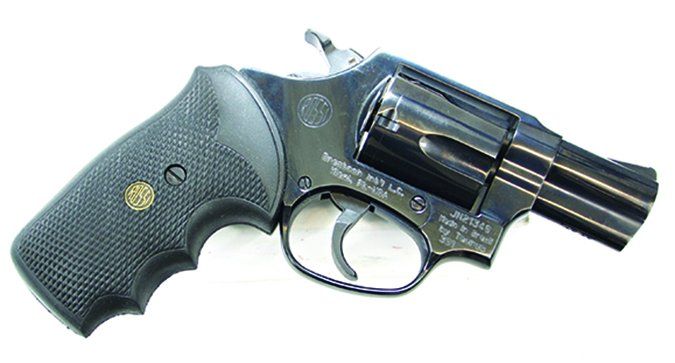
| ACTION TYPE | Revolver, double action |
| OVERALL LENGTH | 6.5 in. |
| BARREL LENGTH | 2 in. |
| SIGHT RADIUS | 3.7 in. |
| OVERALL HEIGHT | 4.7 in. |
| MAX WIDTH | 1.3 in. |
| WEIGHT UNLOADED | 24 oz. |
| WEIGHT LOADED | 28.1 oz. |
| CYLINDER GAP | .006 in. |
| CAPACITY | 5 |
| FRAME FINISH | Blued steel |
| BARREL/CYLINDER FINISH | Blued steel |
| FRAME FRONT STRAP HEIGHT | 2.4 in. |
| FRAME BACK STRAP HEIGHT | 3.2 in. |
| GRIP | Checkered rubber, finger grooves |
| GRIP THICKNESS | 1.1 in. |
| GRIP CIRCUMFERENCE | 5.12 in. |
| FRONT SIGHT | Ramped blade |
| REAR SIGHT | Fixed groove |
| TRIGGER PULL WEIGHT (SA) | 3.2 lbs. |
| TRIGGER PULL WEIGHT (DA) | 12.2 lbs. |
| SAFETY | Internal hammer block, security lock |
| WARRANTY | Limited |
| TELEPHONE | (305) 474-0401 |
| WEBSITE | RossiUSA.com |
| MADE IN | Brazil |
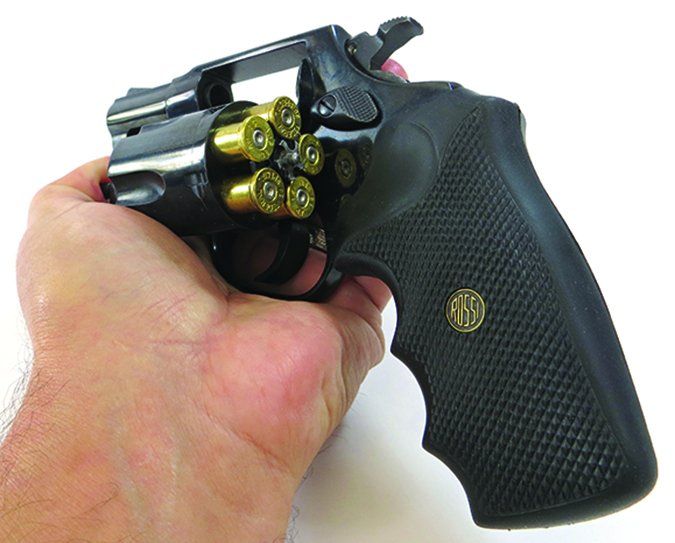
The Rossi is manufactured in Brazil by the same company that manufactures Taurus revolvers. The resemblance to a Taurus and a Smith & Wesson J-frame revolver was obvious. The Rossi had a nice blued finish and a full rubber grip that made the small revolver feel like a full-size unit. The metal-to-metal fit was better than the RIA, with no gaps. The barrel was 2 inches in length with a full shrouded ejector rod, and the front ramp sight was milled into the top of the barrel. The ramp was serrated so there was not glare when aiming in direct sunlight.
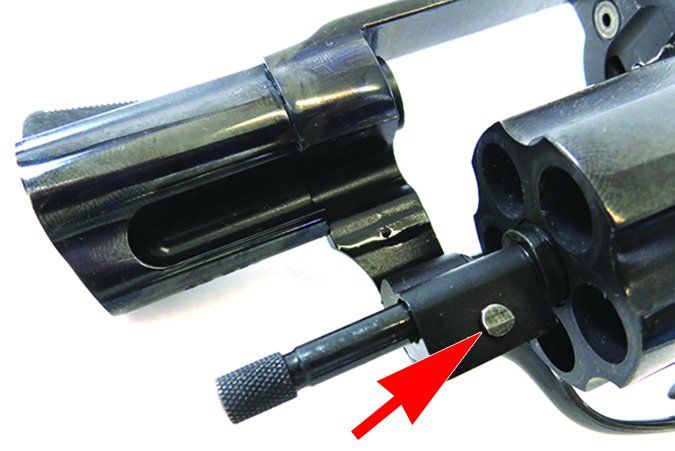
Unlike the RIA and Charter Arms handguns, the Rossi is a SA/DA with a hammer spur nicely checkered and offering a good grip. The hammer was a bit old school with the firing pin attached. The hammer is a rebounding type so the firing pin does not rest on a live cartridge primer, except when the trigger is pulled fully rearward. There was also a hammer-block system similar to those found on S&W revolvers, which is activated when the hammer is cocked in single action. Accordingly, the Rossi is safe to carry with all five chambers loaded. It also included a security lock (like all Taurus revolvers) that requires a key to inactivate and activate the mechanism.
Our initial examination saw a slight bit of wiggle in the cylinder. We ran a range rod down the barrel just to check the chamber-to-barrel alignment and found it was good. All revolvers were within spec, in fact. At the top of the crane was a detent that locked the front of the cylinder to the frame.
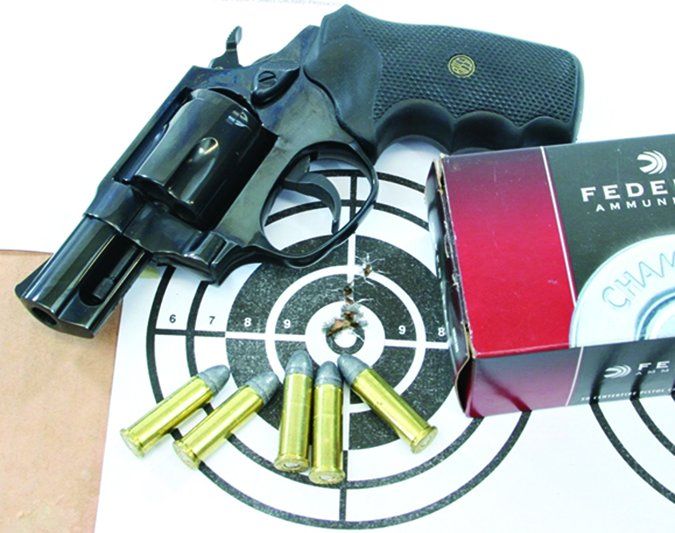
The Rossi had a double-action trigger-pull weight of about 12 pounds, and our shooters felt it had the best trigger of all three revolvers — smooth and consistent. We also felt the grip played a part in the trigger pull, providing plenty of leverage for the hand to work against. The trigger itself was smooth and wide, so the pull actually felt less. In double-action operation, there was a perceptible amount of additional finger press needed to fire the revolver due to stacking.
The cylinder latch slid forward to open the cylinder. The grip and the latch allowed unfettered access to the cylinder with a speed loader. A ring appeared around the cylinder shortly after dry firing and testing the Rossi. A ring and marks on both the Charter Arms and RIA also appeared.
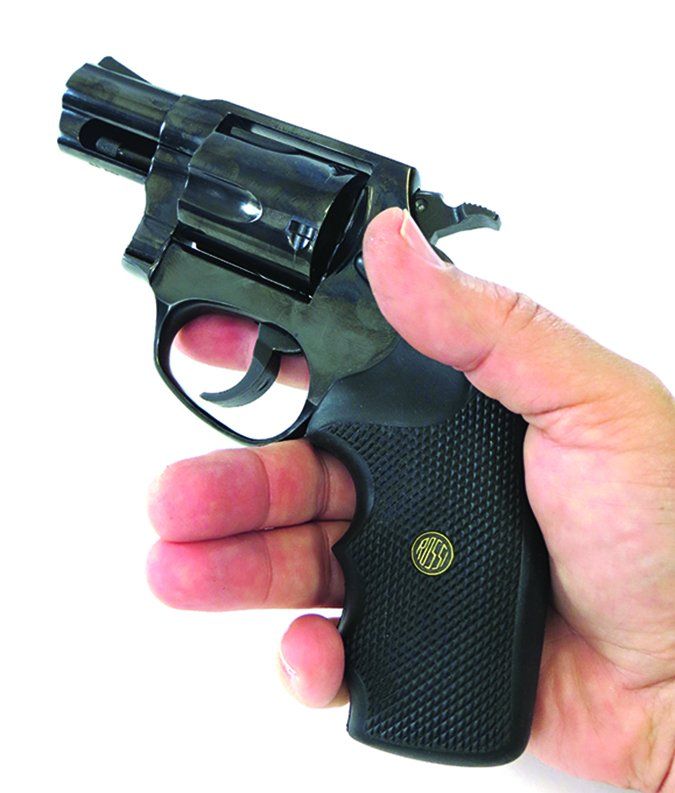
At the range the Rossi was very pleasant to shoot due the grip. Cartridges that stung our hands in the other revolvers did not have the same effect in the Rossi. We fired the Rossi for accuracy in single action and were surprised at the accuracy. It particularly liked the Federal ammo, giving us a best 5-shot group of 0.4 inch. Average accuracy was 1.5 inches for 5 shots across the board. The sights, we thought, were good, slightly smaller than the RIA and Charter Arms sights. We would have liked the rear-sight groove to be notched just above the top of the hammer to relieve glare and provide more contrast.
We used a few holsters designed for a S&W J-frame to tote the Rossi and found the size and weight comfortable to bear. The grip was the largest of the three tested, and if we were to daily carry this revolver, we would opt for smaller grips. No doubt our comfort shooting would diminish as the grips shrunk.
Our Team Said: The Model R35102 was the most comfortable revolver to shoot and it had the best trigger out of the box. The cylinder had play in it, and the grip was a bit too large for deep carry.
Charter Arms Off Duty 5381 38 Special, $404
GUN TESTS GRADE: A
The Off Duty started off with a gritty trigger but soon slicked up; it was the lightest and most compact in this test.
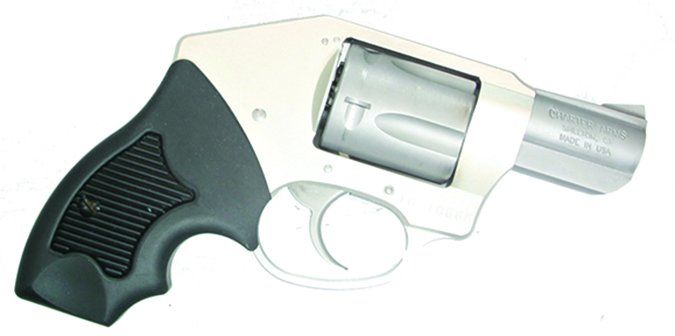
| ACTION TYPE | Double action only |
| OVERALL LENGTH | 6.25 in. |
| BARREL LENGTH | 2 in. |
| SIGHT RADIUS | 3.8 in. |
| OVERALL HEIGHT | 4.9 in. |
| MAX WIDTH | 1.3 in. |
| WEIGHT UNLOADED | 12 oz. |
| WEIGHT LOADED | 16.1 oz. |
| CYLINDER GAP | .006 in. |
| CAPACITY | 5 |
| FRAME FINISH | Matte aluminum |
| BARREL/CYLINDER FINISH | Matte stainless |
| FRAME FRONT STRAP HEIGHT | 1.6 in. |
| FRAME BACK STRAP HEIGHT | 3 in. |
| GRIP | Ribbed rubber, finger grooves |
| GRIP THICKNESS | 1.2 in. |
| GRIP CIRCUMFERENCE | 5 in. |
| FRONT SIGHT | Ramped blade |
| REAR SIGHT | Top groove |
| TRIGGER PULL WEIGHT (DA) | 12 lbs. |
| SAFETY | Internal transfer bar |
| WARRANTY | Limited lifetime |
| TELEPHONE | (203) 922-1652 |
| WEBSITE | CharterArms.com |
| MADE IN | USA |
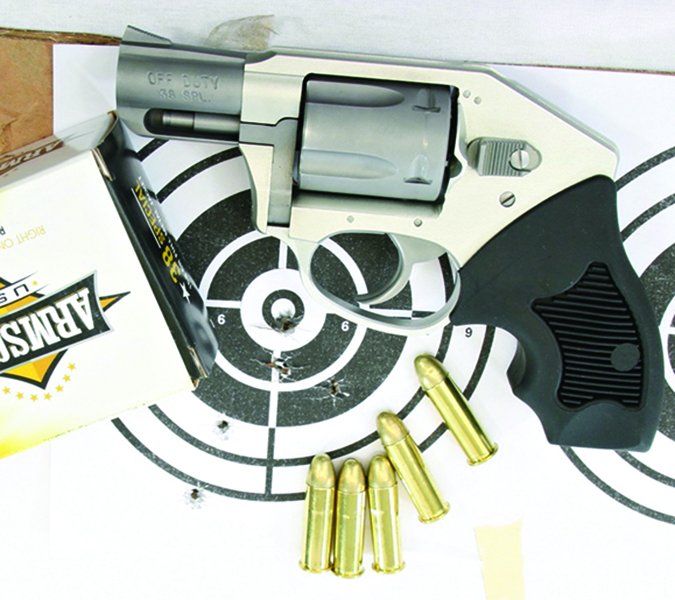
The Off Duty was the smallest and lightest as well as the most expensive revolver tested. It had a hammerless design, meaning the hammer was enclosed within the frame, making the Off Duty smooth and snag free. The frame is made of aluminum and left in a matte finish. The barrel, crane, and cylinder are made of stainless steel with a complementary matte finish. As a result, the gun had a subtle two-tone look that some testers liked.
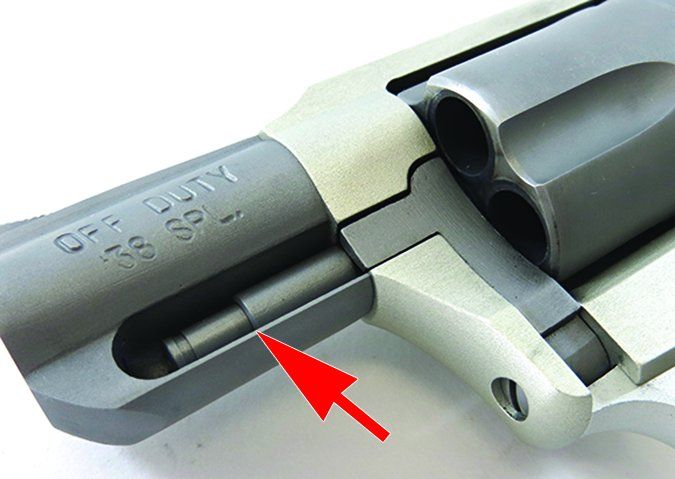
The black rubber grip was minimalist, with finger grooves that positioned our hand in a high, comfortable spot. The sides of the grips also had a slight palm swell and were ribbed for a better grasp. In addition, the grips filled that space behind the trigger guard that the RIA left vacant. In fact, our grip hold was the highest on the Charter Arms, which helped control muzzle flip and perform a fast second shot. We did note that the rubber grip fit to the backstrap overlapped. Not the best fit by any means. We would remove the extra rubber that overlaps the rear back strap. When shooting the Off Duty, we needed to curl the small finger under the grip.
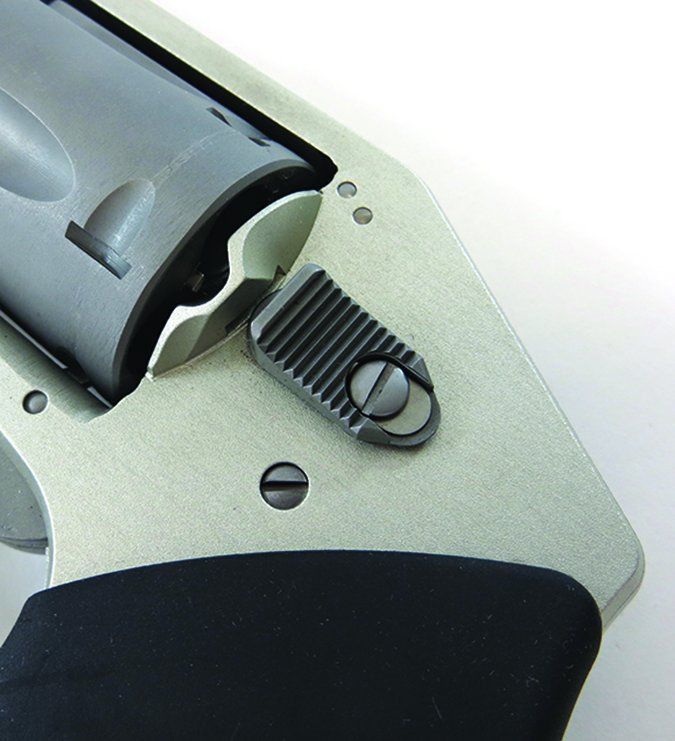
The Charter’s cylinder lock up was the tightest of all three with no wiggle, which gave us more confidence in the design. The Off Duty, like the Rossi, locks the cylinder in the front and rear. The Charter Arms uses the ejector rod, which is nested and in two pieces that telescope to snap back into the frame. The cylinder latch was well serrated and large. It is pushed forward to swing out the five-shot cylinder. Both the grips and latch are speedloader friendly. The front edge of the cylinder had a slight chamfer, which aided reholstering.
The Off Duty revolver employs a one-piece frame, while the Rossi and RIA use a side plate on the frame. The one-piece frame makes the small revolver strong while allowing it to be slightly smaller than the two-piece design of the Rossi and RIA.
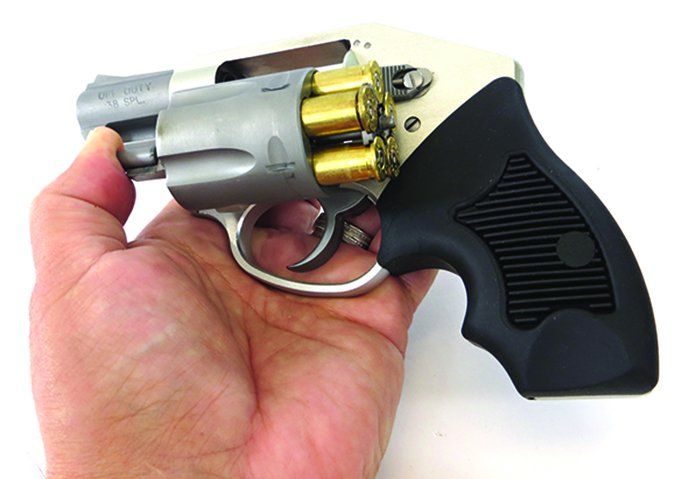
The 2-inch barrel used a full lug that enclosed the ejector rod. The lug was tapered like the Rossi so reholstering was easier. The ramp front sight was milled into the top of the barrel and serrated to minimize glare. The rear sight was a groove along the top. It was also notched so the aluminum rear sight contrasted nicely with the stainless front sight. These were the best sights, in our opinion. Out of the box, the trigger was gritty, but it soon smoothed out with dry-fire practice and range testing. The trigger was serrated in the middle, allowing users to keep the position of their trigger finger the same, even during recoil.
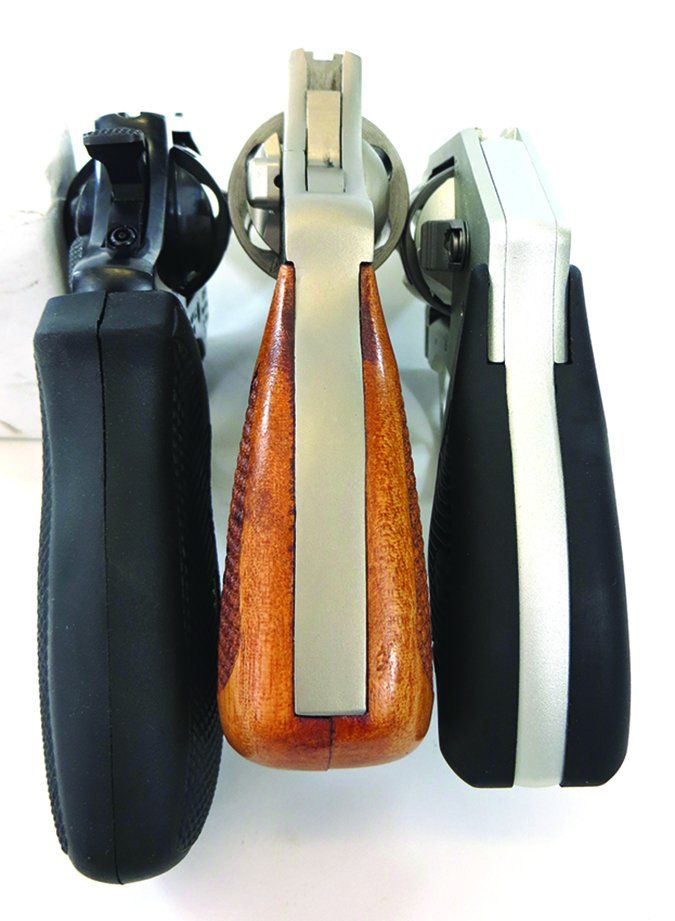
Due to the compact size and light weight of the Off Duty, recoil was most noticeable, whacking the web of our hand at the top position of the grip. The rear of the rubber grips were squared off, and we also felt those edges slap our palms. If the rear edges of the grips were rounded, we believe felt recoil would be less. Though the Off Duty scored lowest in accuracy among the three, we felt 2.0 inches for five shots was acceptable for a close-in defense weapon. We were able to coax it to under an inch with the Federal ammo, and our smallest groups with the Armscor and Hornady ammos hovered around 1.5 inches. The smallish grip and stacking on the last bit of trigger press no doubt hindered accuracy. Empty cases ejected smartly out of the Charter Arms, as they did with the other two.
In concealed carry, the Off Duty shined. It could be carried in a holster designed for a S&W J-frame or dropped in a pants or cargo-pants pocket.
Our Team Said: The Off Duty was the lightest and most compact revolver tested. The trigger was initially gritty, but it smoothed out after use. We would not hesitate to carry this revolver.
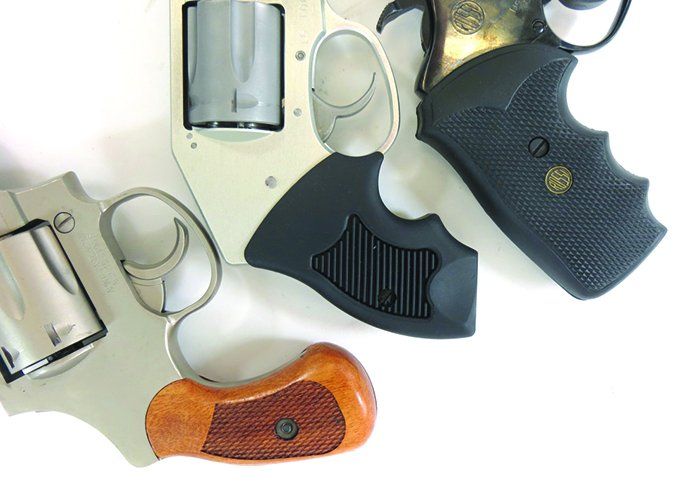
Range Data
| Federal Champion 38 Sp. 158-gr. LRN | Rossi Model R35 102 | Charter Arms Off Duty | Rock Island Armory M206 |
| Average velocity | 649 fps | 658 fps | 613 fps |
| Muzzle energy | 148 ft.-lbs. | 152 ft.-lbs. | 132 ft.-lbs. |
| Smallest group | 0.4 in. | 0.9 in. | 0.5 in. |
| Average group | 0.6 in. | 1.6 in. | 1.6 in. |
| Armscor 38 Sp. 158-gr. FMJ | |||
| Average velocity | 826 fps | 826 fps | 784 fps |
| Muzzle energy | 239 ft.-lbs. | 239 ft.-lbs. | 216 ft.-lbs. |
| Smallest group | 1.3 in. | 1.2 in. | 0.4 in. |
| Average group | 1.6 in. | 2.2 in. | 0.7 in. |
| Hornady Custom 38 Sp. 158-gr. XTP | |||
| Average velocity | 682 fps | 620 fps | 722 fps |
| Muzzle energy | 163 ft.-lbs. | 135 ft.-lbs. | 183 ft.-lbs. |
| Smallest group | 0.7 in. | 1.7 in. | 0.6 in. |
| Average group | 1.7 in. | 2.5 in. | 1.2 in. |
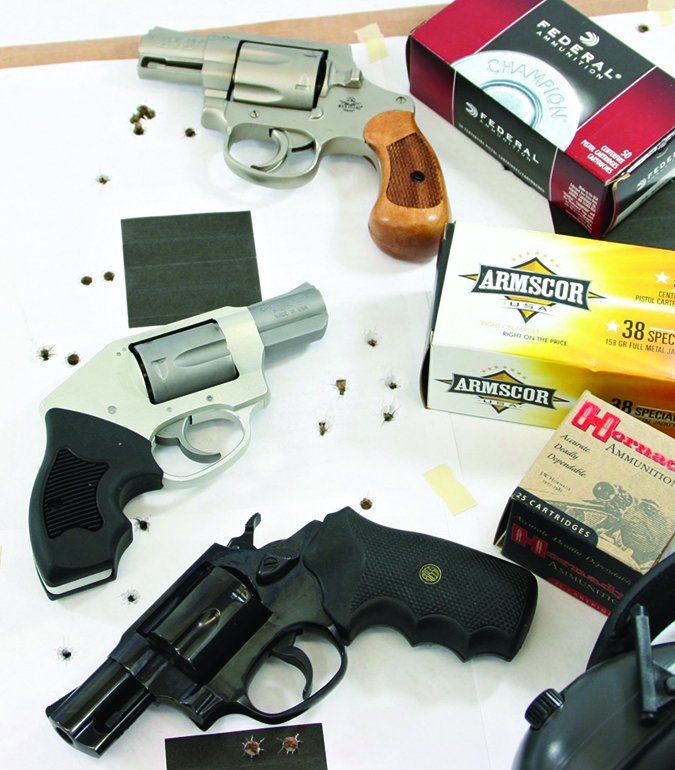
To collect accuracy data, we fired five-shot groups from a bench using a rest. We fired the Rossi single action and the Charter Arms and RIA double action. Distance: 15 yards. We recorded velocities using a ProChrono digital chronograph with the first screen 15 feet from the muzzle.
Written and photographed by Bob Campbell, using evaluations from Gun Tests team testers.



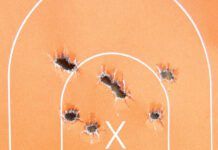














I have had acharter arms for over 25 yrs I love it I sold my s&w mod 36 I like the charter better. Ron Suter
Hope one day soon you review RIA M-200 full size 38special!
Hopefully I can find the charter off duty ….been looking for a long time….